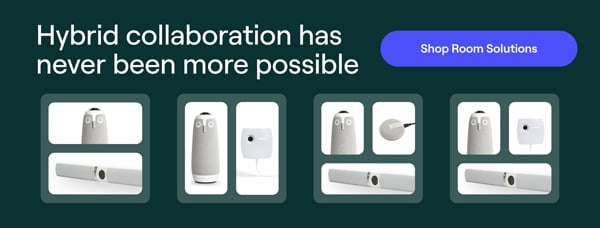Companies today know that hybrid work and letting employees choose where to work is the key to employee satisfaction and productivity. In fact, more than a third of employees feel so strongly about hybrid/remote work that they said they’d quit on the spot if the ability to work from home was taken away - and 62% said they’d take a pay cut of 10% or more.
Yet, over the past four years, only a third of companies have upgraded their video conferencing technology to meet the needs of their hybrid workforce. This post explores what a hybrid team is and how to best manage and support them.
What is a hybrid team?
Hybrid teams combine working from home with working in-person from the office or a shared coworking space. Hybrid companies can create workplace policies where employees are expected to come to the office a few days a week and work from home on other days. Or, hybrid companies can use a more flexible model and let employees choose where they want to work, whether it’s in the office, entirely from home, or a combination of the two. There are two types of hybrid teams: structured and unstructured.

Structured hybrid teams v. unstructured hybrid teams
A structured hybrid team is a team where the organization mandates which days employees have to be in the office. For example, three days in-office and two days remote during a work week is a common structured hybrid team schedule. The advantage of a structured hybrid team is that employees know exactly when teammates are going to be in the office, which gives them consistent time to work together and build social capital.
Unlike a structured hybrid team, unstructured hybrid teams don’t mandate which days employees need to be in the office. Instead, they leave office time up to the discretion of the individual employee. This allows employees greater flexibility (which we know employees value) but it does make it more difficult for teammates to consistently get face time with each other.
Why the future of work is hybrid
Early this year, 50% of office-based workers are back at the office, and many economists and workplace experts expect that offices are unlikely to reach full capacity. Some companies have already right-sized their workplaces to adjust for their new lower capacity needs. Others have switched to operating out of collaborative, bookable coworking spaces, and some have even gone fully remote.
Employees are most productive when they can choose where to work, opting for the working situation that best aligns with their life circumstances and working style. Some employees want social interactions while others want to work independently. Some are distracted by the din of the office, while others listen to coffee shop sounds while working from home because they can’t stand the silence. New parents and elder caregivers might appreciate the flexibility of working from home, while Gen Z employees appreciate the in-person socialization and mentorship that comes from office work.
Employee sentiment has shifted towards remote and hybrid work. In 2023, 66% of employees said they are working in the office full-time, however only 22% of them actually want to be.
Transitioning to a hybrid work model
Many companies already have the tools in place for a transition to a hybrid work model. Over half of the Fortune 500 companies use Zoom to conduct business and tools like Microsoft Teams, Google Workspace, and Slack have developed features for hybrid teams to work seamlessly, independent of location.
When putting together a strategy to move your business to a hybrid work model, use this quick checklist to develop a transition plan:
- Technology
- Who has access? How is tech distributed? What does IT support look like for hybrid workers?
- Communication
- What are the expectations for remote and hybrid employees? Will you implement meeting free days or a shorter work week?
- Benefits + policies
- Think about how these differ based on country-specific laws and regulations, regional differences, and equity in benefits.
- Culture
- How will you maintain the employee experience and build culture as a hybrid organization? Think of how you can redistribute budgets and staff hours to meet new employee needs.
- Real estate
- How will hybrid work impact workplace utilization and real estate needs? Consider implementing a workplace intelligence system like Robin or VergeSense to track usage before making real estate decisions.
What does a functioning hybrid team look like?
While the specifics of individual team dynamics are going to be unique for each team, there are some persistent qualities that every successful hybrid organization has. These qualities include:
On-site employees + managers
A truly successful hybrid team needs to have employees who spend the majority of their time in the office. These employees are the primary connection to the office for their remote counterparts. On-site managers need to make sure their organization is investing and utilizing hybrid technology to ensure that remote employees have everything they need to easily collaborate with anyone in the office.
Remote employees
The employees who turn a typical in-person team into a hybrid team are the ones who spend the majority of their time working remotely. Remote employees need to embrace hybrid technology like video conferencing and messaging software to connect with their in-office colleagues in natural and effective ways.
The truth is that some people are better at working remotely than others. In fact, there are five specific qualities that hiring managers should keep in mind when they are hiring for remote roles.
Hybrid managers
It’s important to have a manager dedicated to helping your hybrid team succeed. Hybrid teams face unique challenges, like asynchronous work schedules, proximity bias, and separation from company culture and connection. A hybrid manager can work closely with in-office and remote employees to stay ahead of these common challenges and make sure employees have the tools they need to succeed wherever they choose to work. Just like hybrid work is a skill that can be learned and improved upon, so can hybrid management.
How to manage a hybrid team
Managing a hybrid team is more complex than managing a fully onsite team — or a fully remote team, for that matter. Hybrid work is characterized by a need for flexibility and adaptability—but with smart video conferencing tech, targeted benefits packages, and a culture of transparency and communication, every employee on your team will be able to thrive.
Here’s how to run a successful hybrid team:
Update benefits packages to reflect the needs of all employees
An onsite gym and a parking stipend won’t do much for remote employees, so build distinct benefits packages that materially improve the quality of life for both onsite and remote employees.
For example, provide a universal fitness stipend for employees to use on gyms or classes, and provide a home office stipend for remote employees to improve their workspaces. Also, ensure that remote employees have healthcare coverage that connects them to the best providers in their state of residence if it’s different from where the office HQ is.
And when it comes to perks like company swag, don’t forget to mail out swag to primarily remote employees.
Create benchmarks for promotion so all employees know how to grow
49% of remote workers feel that managers see them as less hard-working than their in-person peers. Counter that fear by building promotion tracks with clear milestones and responsibilities for every employee, whether they’re primarily in the office or remote.
Plan virtual social events and occasional in-person gatherings
Strengthen team bonds with regular, casual hybrid meetings that let people get to know one another and plan in-person gatherings on a quarterly basis.

Upgrade office video conferencing technology
Remote employees report having a harder time communicating in hybrid meetings due to poor video conferencing technology. When was the last time you took a look at your hybrid team’s tech stack? Get feedback from your team and rethink your meeting space technology.
Make hybrid meetings easy
Communication is the key to successful hybrid teams. Make it easy for your team to meet whether that’s a quick video call, an instant message between employees in different time zones, a company-wide employee town hall, or a board meeting across different office locations.
Hybrid team communication
Build a proactive, transparent, communicative team culture. Hybrid and remote teams need to place a stronger emphasis on clear communication and collaboration, and it starts from leadership. Valuing autonomy and trusting your employees to get their work done is the foundation of successful hybrid work.
Make sure all employees feel valued, and that their contributions to the team are being noticed and appreciated. Plan 1:1 meetings on a weekly or biweekly cadence where managers can just chat with direct reports, whether it’s in-person or on a video call, to go over priorities, wins, and areas of improvement.
It’s also important to set team norms around communication: what should be sent as an email? What kind of conversations are better over video calls? And which ones can be casual Slacks? Plus, determine a team-wide time expectation on returning emails and Slacks—for example, an hour or two for urgent issues, and half a workday for non-urgent messages.
And if your team does work that can be done asynchronously, learn about the nuances of asynchronous work and how hybrid teams can benefit from this approach.
Tips for supporting + motivating hybrid teams
- Use tools like 15Five to keep your hybrid team connected and monitor engagement.
- Regularly gather anonymous feedback from your team.
- Build culture over time and be open to suggestions.
- Be vulnerable and transparent as a leader.
- Take time off and encourage your team to do the same. (Real-time off, no Slack or email allowed)
- Set aside time for team building.
- Celebrate wins together and review misses together.
Being an inclusive hybrid team leader
Leading a hybrid team requires a new understanding of diversity, equity, and inclusion (DEI). Remote and hybrid work contributes to more accessibility in the workplace, but to be an inclusive leader, you have to understand how to give every one of your team members their own individualized support.
Seek out support from DEI consultants and specialists to help develop an equitable hybrid work environment—they may uncover gaps in your workplace environment and access that you didn’t see.
Hybrid team technology solutions
One of the most important steps in creating a productive and equitable hybrid work environment is taking inclusivity into account for all meetings. Make sure that all employees feel seen and heard. Upgrade your virtual meeting technology to a system built specifically for hybrid meetings.
Owl Labs products were built for hybrid teams, and our suite of hybrid collaboration tools are designed to make every meeting participant feel included and connected, whether they’re calling in from home or sitting in a meeting room in the office.
Hybrid teams should invest in:
- Video conferencing apps: Look for a video conferencing platform that’s not laggy, anyone can use, allows for recordings, and is available globally.
- Video conferencing cameras for meeting spaces: Your video conferencing camera should be plug-and-play, and intelligent like the Meeting Owl, so hybrid meetings can start in seconds, not minutes. And in-person employees aren’t hit with the tech burden of trying to get the camera started.
- The Owl Bar: The Owl Bar is a front-of-room camera, microphone, and speaker that pairs with the Meeting Owl 3 for more immersive meeting experiences.
- A whiteboard camera: Hybrid team collaboration between creative teams will lead to remote workers trying to see a whiteboard. Invest in a whiteboard camera like the Whiteboard Owl for better hybrid brainstorming.
- Room booking platforms: Apps like Robin make it easier for employees to book a desk or meeting room when they’re in the office.
- Messaging apps: Messaging and productivity platforms like Slack have options for users to set their working hours, show their time zone, jump on a quick audio or video call, and add tons of apps to support asynchronous work.


